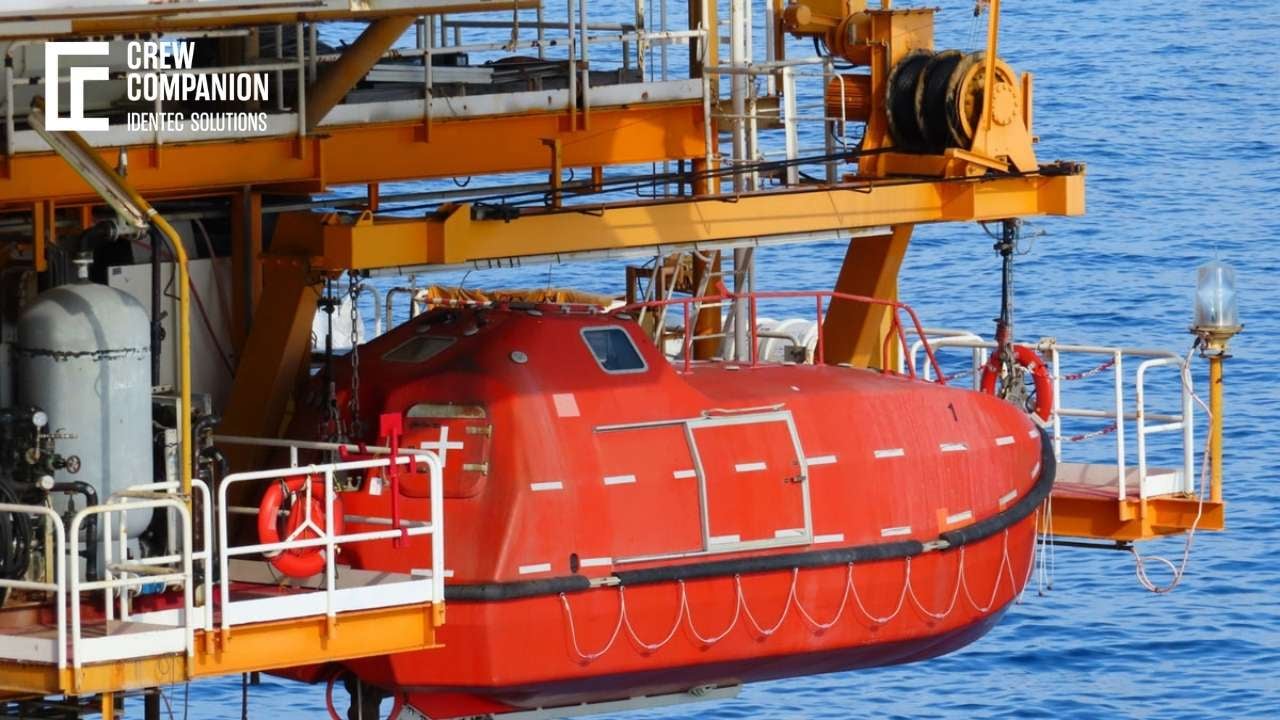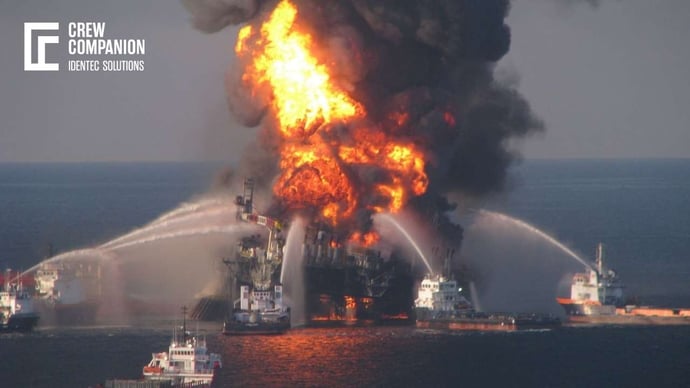Why should you record your (offshore emergency) practice?
| Written by Mark Buzinkay

No video selected
Select a video type in the sidebar.
Imagine a team practice session. You get a task as a team in different areas of the offshore installation and execute. After half an hour, the training is called. You did not bad, but it could be better. Next week, same time... and the results are almost the same. You start thinking and analyzing, but it is difficult to be aware of everything of what you did, even you do while practicing.
The only way is to get feedback from someone or something that observed your practice session and audits your rig safety. It "detaches" you from the actual practice and provides crucial information about the reasons for your performance as a team. But how we can do that in a complex area with rooms, gangways, bridges, stairs and so many levels?
Further reading: Offshore safety equipment
The answer is to record your practice sessions and then review and analyze your recordings. The advantage is that, when you are calm, it is much easier to identify mistakes and figure out what can be improved. After all, you can’t fix something until you know what it is. Actually, many organisations and individual people use this concept for presentations, public speaking, coaching, and even sports. In all these disciplines, people use this technique to improve quickly and efficiently through reviewing their practice and performance.
Why is Performance Awareness Good Offshore Emergency practice?
Maybe the most important reason to record your (offshore emergency) training and then review the recording is to build awareness on how you perform - e.g. emergency mustering. For instance, when reviewing sports recordings, you can notice your positioning on the field, your technique or your collaboration with your teammates, in case of a team sport. Imagine a team on your oil rig.
Another important reason to review recordings is to identify strengths and weaknesses of your team' performance (read more about EHS risk assessment). Like an observer, you access and analyse recorded data and in the process identify mistakes. In this way, you practice on what you need the most to improve. This is learning.
And there is another area of getting better in what you do by recording and reviewing your practice sessions: Identifying lazy practice. What does it mean? That is when you practice only what you are already good at. You run the same drill you perform well, but don't exercise other aspects of team work because they are difficult. It is easy to see that you can't learn anything from such a training culture. But if you practice all aspects of your work, you will see progress. When recorded, it can be very motivating for your team to monitor progress.
Good use of recordings is to focus on one mistake or field of improvement at a time. Identify the area with the improvement potential and work on this. Once satisfied with the plateau you and your team reached, move on to the next mistake. By this, you focus always on one aspect of your training. And a last how-to suggestion would be to show the recordings to experienced peers and ask for their opinion. They can provide you with qualitative feedback and point out other areas of improvement you may have missed out.
Learn more about "e Mustering" and how to improve your mustering practice!
offshore emergency practices: How to record a session?
An offshore oil rig is a complex, maze-like structure where critical emergency drills are routinely performed. Given the potential hazards and the high stakes involved, perfecting these emergency responses is not a choice but a mandate. Thus, accurate recording of these training sessions is paramount.
The need for recording arises from a fundamental understanding that deliberate practice, review, and iteration of these emergency drills could be the difference between life and death during emergencies. However, it is essential to acknowledge that offshore installations' sheer complexity and expansiveness make recording these sessions somehow challenging. Here, we delve into the practical aspects of achieving this feat and deriving actionable insights from the recorded data.
Choosing the Right Medium of Recording
The choice of recording medium largely depends on the nature of the drill, your budget, and the specific area of improvement you are targeting. Two popular methods are video recording and the use of transponders.
Although a seemingly straightforward option, video recording can be quite cumbersome, given the architecture of offshore installations. Installing cameras in every nook and corner of the rig to capture every movement during the drill could turn out to be logistically challenging and financially draining.
On the other hand, transponders or personal beacons attached to each person involved provide a simplified and relatively inexpensive alternative. These devices can help track movements across the installation and provide a real-time record of the drill. While they might not provide a visual reference, they offer valuable data regarding the spatial and temporal dynamics of the drill.
Understanding the Objective
The objective behind recording a drill will largely dictate the approach you adopt. If your focus is on understanding team coordination and individual response times, tracking devices serve you better than video recording. If, however, you are more interested in evaluating the team members' technical competence and procedural accuracy, a visual medium might be more appropriate.
Analyzing the Data
Once you have recorded the drill, it's time to extract actionable insights from the data. This requires a comprehensive, pre-determined concept of improvement.
If you are using video, watching the footage in real-time and slow-motion can help identify the strengths and weaknesses of the team, assess technical competencies, and spot procedural errors. If you are using tracking devices, the data can be utilized to map the movement of each individual, understand the coordination among the team members, and calculate response times.
Iterating on the Findings
The process of recording drills isn't just about identifying faults; it's about building on strengths and correcting weaknesses. Once the shortcomings have been identified, targeted training sessions should be arranged to work on these areas. Similarly, practices that have proven effective should be reinforced and replicated.
The Broader Benefits
Recording and reviewing practice sessions extend beyond immediate drill performance improvement. It instils a sense of accountability and discipline among the team members, allowing them to visualize their actions and see the impact of their decisions. It encourages a culture of deliberate practice, fostering a mindset where continuous learning and improvement become the norm rather than the exception.
While recording oil rig emergency drills might seem like a logistical challenge, the benefits far outweigh the effort. It serves as an excellent tool to enhance drill performance and lays the foundation for a safety-oriented, performance-driven culture within the organization. Remember, the ultimate goal of these drills is to prepare for potential emergencies, and there is no room for complacency when lives are at stake. It will improve your offshore emergency response greatly.
Continue reading for more on Emergency Response Management.

Continuous Learning and Adapting to Enhance Training
Recording of your offshore emergency practice will also provide systematic training based on iteration of learning and continuous improvement. By documenting each session, you build a repository of experiences and lessons that you can revisit and analyze over time for a clear picture of exactly how your team's performance evolves. The historical data allows pinpointing performance trends, both good and bad, to undertake specific training. For instance, you may notice a recurrence of the same type of mistakes or inefficiency in operations that could show you where you should interfere somehow or even change something within your training program. In addition, recorded sessions provide an opportunity for personalized training modules based on real scenarios that occur during training exercises. These can also be useful during the orientation of new team members through offering them a realistic preview of what to expect and how to respond appropriately in emergencies. They can also be used to achieve cross-learning among teams by sharing insights and best practices across different shifts or departments. This, in turn, expands the knowledge base of the entire workforce and installs a culture of collaboration and collective responsibility regarding safety. Finally, recording and reviewing emergency drills is a practice that turns training from rigid routine to dynamic continuous learning and adaptation. It drives home preparedness while reinforcing the thinking that safety is a journey and not a destination and that your team is always ready and confident to handle any emergency.
FAQs
What is the best method for recording offshore emergency drills?
The "best" method depends mainly on your training objectives, the available budget, and the logistical challenges you face. While video recording provides a visual reference that helps assess technical skills and procedural accuracy, it might be logistically challenging and costly on an offshore installation. On the other hand, transponders or personal beacons can track individual movements across the rig and provide valuable data regarding the spatial and temporal dynamics of the drill. Ultimately, balancing these factors is essential and choosing the method that best suits your needs.
What can we learn from the recorded data of emergency drills?
There's a wealth of information that can be extracted from recorded drill data. Video footage allows for assessing technical skills, procedural adherence, and team coordination. It also aids in identifying potential areas of weakness and areas of strength. In contrast, data from personal beacons can help understand team coordination, individual response times, and the overall flow of the drill. Both can provide invaluable insights to improve the efficacy and efficiency of your emergency response.
How can we use the insights gained from the recorded drills for improvement?
Once you've recorded and analyzed the drills, the next step is to use the insights to guide targeted improvements. Identified weaknesses should be addressed through additional training sessions or procedure amendments. Recognized strengths can be reinforced and emphasized during future drills. Additionally, sharing these recordings and insights with the team can encourage self-assessment and instil a culture of continuous learning and improvement. Remember, the goal is not to use these recordings for punitive measures but to foster a proactive approach to safety and efficiency.
Takeaway
Recording offshore emergency drills offers an invaluable resource for immediate and long-term safety and efficiency improvements. Whether through video footage or personal beacon data, the ability to analyze and learn from each drill promotes a culture of accountability, continuous learning, and deliberate practice. While the logistics of recording these drills can be challenging, the resulting insights offer clear paths to enhanced performance and increased safety – crucial aspects of offshore operations.
Training is unavoidable, but the question remains how to transfer knowledge in time and how to gain lost knowledge effectively. For more detailed insights on this topic and a comprehensive guide on optimising crew training offshore, we invite you to download our in-depth whitepaper (emergency response training). Harness the power of deliberate practice and drive a safety-oriented, performance-driven culture within your organization.
Dive deeper into one of our core topics: Emergency Response Management
Glossary
Emergency Drills in Offshore - structured training exercises conducted on offshore installations, such as oil rigs, platforms, and vessels, to prepare personnel for potential emergency situations. These drills simulate real-life scenarios, including fires, gas leaks, explosions, medical emergencies, man-overboard incidents, and abandon-ship procedures. They help ensure crew members are familiar with emergency response protocols, safety equipment, evacuation routes, and communication systems. Regularly conducted in compliance with industry regulations (e.g., IMO, OSHA), emergency drills enhance preparedness, improve coordination, and minimize risks, ultimately protecting human lives, the environment, and offshore assets in high-risk operational environments. (3)
Sources:
(1) https://www.sciencedirect.com/science/article/pii/S0950423024000330
(2) https://www.offshore-mag.com/home/article/16804800/emergency-preparedness-study-seeks-to-quantify-best-practices
(3) https://www.sciencedirect.com/science/article/pii/S0950423024000330
Note: This article has been updated on the 6th of March 2025

Author
Mark Buzinkay, Head of Marketing
Mark Buzinkay holds a PhD in Virtual Anthropology, a Master in Business Administration (Telecommunications Mgmt), a Master of Science in Information Management and a Master of Arts in History, Sociology and Philosophy. Mark spent most of his professional career developing and creating business ideas - from a marketing, organisational and process point of view. He is fascinated by the digital transformation of industries, especially manufacturing and logistics. Mark writes mainly about Industry 4.0, maritime logistics, process and change management, innovations onshore and offshore, and the digital transformation in general.





